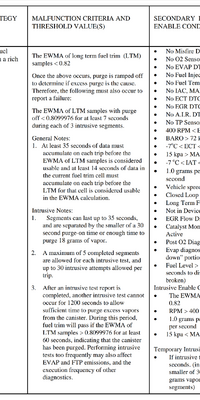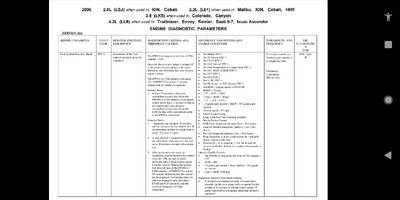It was constant little ups and downs compared to the other side that went from roughly .2 to .9is the chart of the o2 s2 b1 always showing the same single "wave" pattern during idle? Or is this just one time event?
You are using an out of date browser. It may not display this or other websites correctly.
You should upgrade or use an alternative browser.
You should upgrade or use an alternative browser.
Persistent p0172 and p0175
- Thread starter MBS1994
- Start date
I'll be sending the computers back once my shift kit is in so I'll have to ask if they can double check. I'm on lunch break so I'm going to try to at least put my o2 extensions in and see if that changes anything on b1s2Ahhh. As long as the O2 sensors are directly in the exhaust stream. I have heard of downstream O2 sensors being offset out of the exhaust stream in a attempt to fool the system into thinking that cats are workimg OK, or something like that.
I just verified that Car Scanner is using the standard mode pids 14 & 15 to get their O2S readings. I think these are legislated diagnostics but I don't know what is possible as far as a tune modifying such things. Only your tuner would know if anything has been done to fudge these readings. On my 4.2 Trailblazer there is another set of PIDs using the extended mode $22 that also display these readings. I just now compared the two and while they are very similar they are not identical it would seem.
I realised before I was looking at a rear o2 that was the .44 volts so I'm not sure that the b2s1 was even a problem but I did hook up the extension. Only thing I can see that really seemed to change was the idle seems steadier and the evap pressure went from -7k to positive 3k
Attachments
-
 Screenshot_20200807-123750.jpg222 KB · Views: 3
Screenshot_20200807-123750.jpg222 KB · Views: 3 -
 Screenshot_20200807-123923.jpg199.2 KB · Views: 3
Screenshot_20200807-123923.jpg199.2 KB · Views: 3 -
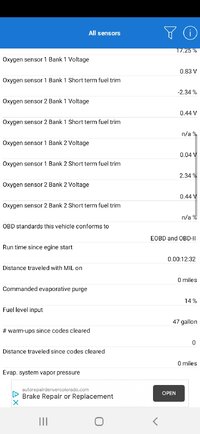 Screenshot_20200807-123947.jpg209.2 KB · Views: 2
Screenshot_20200807-123947.jpg209.2 KB · Views: 2 -
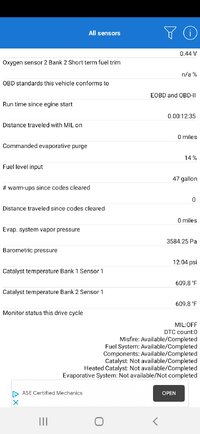 Screenshot_20200807-123952.jpg225.6 KB · Views: 2
Screenshot_20200807-123952.jpg225.6 KB · Views: 2 -
 Screenshot_20200807-124108.jpg209.3 KB · Views: 2
Screenshot_20200807-124108.jpg209.3 KB · Views: 2 -
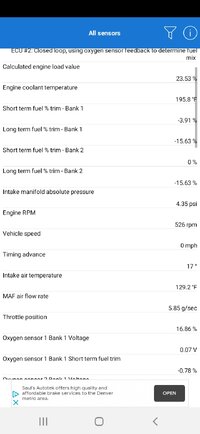 Screenshot_20200807-124218.jpg196.3 KB · Views: 2
Screenshot_20200807-124218.jpg196.3 KB · Views: 2 -
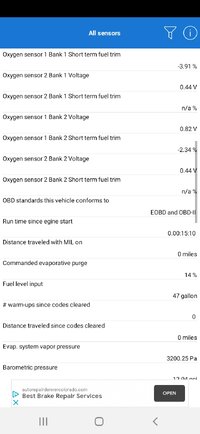 Screenshot_20200807-124225.jpg209.5 KB · Views: 1
Screenshot_20200807-124225.jpg209.5 KB · Views: 1
sorry, I also mixed up "banks", "sides", and "sensors". Sensor 2 on either bank are post cat and you indicate they are physically not there or are connected but hopefully, "removed" in some fashion as to not cause a "check engine light" and / or "code". Sensor 2's should be relatively flat once warmed up.
I do the same all the time. I have my upstreams in and in my y pipe there is only one spot for a single rear which I believe is a wideband for tuning. OOOOH I had a thought typing that, could one rear sensor be still left in the computer to be used for tuning and since I dont have one in the exhaust or harness that could be causing it?sorry, I also mixed up "banks", "sides", and "sensors". Sensor 2 on either bank are post cat and you indicate they are physically not there or are connected but hopefully, "removed" in some fashion as to not cause a "check engine light" and / or "code". Sensor 2's should be relatively flat once warmed up.
evap pressure went from -7k to positive 3k
Evap pressure will vary according to driving conditions. When the PCM decides it's a good time to purge the canister it will open the purge valve using a percentage value using PWM. At highway cruising it could be at 100%. At idle it could be zero. So... The evap needs to be monitored at a range of usage conditions.
Never mind I read my readings wrong. Both o2s read .44v but fuel trim is NA. Back to the drawing board
Fuel trim for downstream sensors (O2S2) will always have n/a. The downstream sensors are not used in fuel trims.
Pcm said they turned off all codes for my rears so another confirmation that I was wrong....again.
Now to me.... I would think "turning of the codes" does not remove the data, just stops the PCM from checking on that data and setting a check engine light. I would expect any available data to still be there. But in the case of the sensors being removed there would/should be no data there. At least that's what I would guess.
So the computer could still be detecting no data from the rears possibly causing problems that aren't being report or possibly causing the issue on my fronts?Now to me.... I would think "turning of the codes" does not remove the data, just stops the PCM from checking on that data and setting a check engine light. I would expect any available data to still be there. But in the case of the sensors being removed there would/should be no data there. At least that's what I would guess.
So the computer could still be detecting no data from the rears possibly causing problems that aren't being report or possibly causing the issue on my fronts?
No, no, no. Downstream (rears) do not affect anything, they are there ONLY to prove the catalytic converters are working.
N
No I will. I've been working all day but I live where I work so I get chances to work on it here and there through the dayOK... but I ask again, have you tried disconnecting the MAF and then checking your trims there after?
I unplugged it and it died same with the mapOK... but I ask again, have you tried disconnecting the MAF and then checking your trims there after?
Continuing my suspicion of the evap at -7000 +/-. Here is what that equates to in inches of H2O.
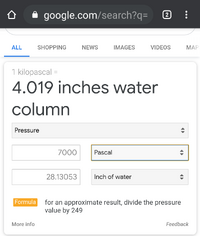
That's a little over 28 inches of water column. I just tried to run a test on my Yukon 5.3. called the purge and seal test in the Tech 2. Essentially it closes the vent and opens the purge valve in order to put the fuel vapor system, tank included under a vacuum and you then press the 'seal system' button to close the purge valve and then see if the evap system (tank included) holds the vacuum. Well not reading any instructions for the test I let it go for a while watching the vacuum, reported in inches H2O climb. When it got around -14 the Tech 2 aborted the test with a message saying that much vacuum was too high. 14 inches H2O was too high. You've seen double that!
Now we must remember that when this system is purging it is pulling in fuel vapors into the intake manifold. Fuel vapors. Into the intake manifold. If something is amiss in this sytem and the vacuum is getting that high I can't help but believe this is going to affect fuel trims.

That's a little over 28 inches of water column. I just tried to run a test on my Yukon 5.3. called the purge and seal test in the Tech 2. Essentially it closes the vent and opens the purge valve in order to put the fuel vapor system, tank included under a vacuum and you then press the 'seal system' button to close the purge valve and then see if the evap system (tank included) holds the vacuum. Well not reading any instructions for the test I let it go for a while watching the vacuum, reported in inches H2O climb. When it got around -14 the Tech 2 aborted the test with a message saying that much vacuum was too high. 14 inches H2O was too high. You've seen double that!
Now we must remember that when this system is purging it is pulling in fuel vapors into the intake manifold. Fuel vapors. Into the intake manifold. If something is amiss in this sytem and the vacuum is getting that high I can't help but believe this is going to affect fuel trims.
ARe we talking about the same thing.... I said MAF and you are saying MAP... these are NOT the same devices. You need to do the MAF ... NOT the MAP. This is a test of air intake controls.
@budwich
Got a question... I don't have a maf so haven't looked into it. When there is both, is the system running speed density or whatever is used when not running speed density? An area I know very little about.
It did drop to 3k and some change after the o2 extension. So maybe purge valve? And does it matter in that first picture it was negative 77k or not really, now its positive 33Continuing my suspicion of the evap at -7000 +/-. Here is what that equates to in inches of H2O.
View attachment 96126
That's a little over 28 inches of water column. I just tried to run a test on my Yukon 5.3. called the purge and seal test in the Tech 2. Essentially it closes the vent and opens the purge valve in order to put the fuel vapor system, tank included under a vacuum and you then press the 'seal system' button to close the purge valve and then see if the evap system (tank included) holds the vacuum. Well not reading any instructions for the test I let it go for a while watching the vacuum, reported in inches H2O climb. When it got around -14 the Tech 2 aborted the test with a message saying that much vacuum was too high. 14 inches H2O was too high. You've seen double that!
Now we must remember that when this system is purging it is pulling in fuel vapors into the intake manifold. Fuel vapors. Into the intake manifold. If something is amiss in this sytem and the vacuum is getting that high I can't help but believe this is going to affect fuel trims.
Yes I unplugged the MAF and it died so while i was right there i unplugged the MAP since the MAP has been suggested as a culprit and it died doing that tooARe we talking about the same thing.... I said MAF and you are saying MAP... these are NOT the same devices. You need to do the MAF ... NOT the MAP. This is a test of air intake controls.
It did drop to 3k and some change after the o2 extension. So maybe purge valve? And does it matter in that first picture it was negative 77k or not really, now its positive 33
The Evap is read by a sensor on top of the fuel tank. It is a reading of the vacuum level inside the tank. Nothing you do with any oxygen sensors can change the vapor pressure inside the fuel tank.
I believe your charcoal canister is somewhat clogged. When that gets clogged and the purge valve opens the air that is supposed to be coming in through the vent valve then through the canister and on to the intake manifold can't get through. So the fuel tank vacuum level rises. Rise enough and you start pulling a lot of fuel vapor from the tank into the intake manifold where all this extra fuel vapor makes the mixture rich and the PCM dutifully lowers the fuel trims trying to adapt to this extra fuel intake. This is my theory for your low fuel trims.
During my test just now as the vacuum level in my tank rose the engine struggled to maintain a decent idle. Damn near stalled a few times due to the fuel vapors I was sucking in from the fuel tank.
Mine does idle rough here and there, I have replaced that canister twice as of now. I'm ready to roll it off a cliffThe Evap is read by a sensor on top of the fuel tank. It is a reading of the vacuum level inside the tank. Nothing you do with any oxygen sensors can change the vapor pressure inside the fuel tank.
I believe your charcoal canister is somewhat clogged. When that gets clogged and the purge valve opens the air that is supposed to be coming in through the vent valve then through the canister and on to the intake manifold can't get through. So the fuel tank vacuum level rises. Rise enough and you start pulling a lot of fuel vapor from the tank into the intake manifold where all this extra fuel vapor makes the mixture rich and the PCM dutifully lowers the fuel trims trying to adapt to this extra fuel intake. This is my theory for your low fuel trims.
During my test just now as the vacuum level in my tank rose the engine struggled to maintain a decent idle. Damn near stalled a few times due to the fuel vapors I was sucking in from the fuel tank.
Mine does idle rough here and there, I have replaced that canister twice as of now. I'm ready to roll it off a cliff
I am guilty of topping off my gas tank. I believe this contributes greatly to canister demise.
I use to have a bad habit of 10 bucks here and there until everyone gave me enough crap about it. I'll try and then I guess if it's not that from the sounds of everything try the MAP since that's been suggested a lotI am guilty of topping off my gas tank. I believe this contributes greatly to canister demise.
So the whole time I was assume the vapor canister was the vent canister in the rear but have you been referring to both. I replaced the vent canister twice and never touched the perg canister. I'm about to replace both and the gas cap.I am guilty of topping off my gas tank. I believe this contributes greatly to canister demise.
well, that is rather interesting. That would appear to put more "guilt" on the MAP as in idle, the MAF has little or no contribution to "running parameters" and in general, the vehicle should run without it. Based on my limited experience which comes from trying 3-4 MAPs from various "ebay sources"... :-( when the MAP "sucks", pushes the "density values" way out. Every unit that I tried would go into significant leaning. I finally got one which was "normal". It is possible that the "relearn" may not have taken but I blamed faulty MAPs, either poor quality or wrong "xref part" (ie. multi vehicle part).Yes I unplugged the MAF and it died so while i was right there i unplugged the MAP since the MAP has been suggested as a culprit and it died doing that too
My understanding during my "battle" is that during idle, the system relies on the MAP (plus regular others...O2, temp). At "speed", the system "blends" the MAP and MAF characteristics into the fold.@budwich
Got a question... I don't have a maf so haven't looked into it. When there is both, is the system running speed density or whatever is used when not running speed density? An area I know very little about.
That is coming from the "site tuner" which every one directs the PCM for "tuning"... sorry I forget the id.
I dont know why it hasn't dawned on me but my wife's car is a 6.0 tahoe. I could use her car as kinda a testerwell, that is rather interesting. That would appear to put more "guilt" on the MAP as in idle, the MAF has little or no contribution to "running parameters" and in general, the vehicle should run without it. Based on my limited experience which comes from trying 3-4 MAPs from various "ebay sources"... :-( when the MAP "sucks", pushes the "density values" way out. Every unit that I tried would go into significant leaning. I finally got one which was "normal". It is possible that the "relearn" may not have taken but I blamed faulty MAPs, either poor quality or wrong "xref part" (ie. multi vehicle part).
So the whole time I was assume the vapor canister was the vent canister in the rear but have you been referring to both. I replaced the vent canister twice and never touched the perg canister. I'm about to replace both and the gas cap.
What I mean by "topping off" is not stopping when the gas pump clicks off. Trying to squeeze more gas into the tank leads to liquid fuel getting into the charcoal canister which leads to the canister getting clogged up. Or so I have read.
Unrelated comment: saw your atmosperic pressure was 12.6 psi. Figured that to be 4000 feet elevation and wondered where. Just now checked your about info and saw Colorado. I'm usually about 10.8 psi at 8200 feet in Colorado!
So there was a problem with the map. Parts of my wiring harness were chewed up. I ran tests after and I have voltage and ground and also voltage drops and arises depending on vacuum like it should. Still dies when I unplug the MAF.
That's all part of the evap system right? I'm thinking I may need a new purge valveUnrelated comment: saw your atmosperic pressure was 12.6 psi. Figured that to be 4000 feet elevation and wondered where. Just now checked your about info and saw Colorado. I'm usually about 10.8 psi at 8200 feet in Colorado!
Back to negative 15. So something I noticed messing with the purge valve. If I unplug it by the intake manifold, the manifold has a nipple that creates vacuum and from the hose i unplugged i can hear a clicking and it smells like fuel. Now i unplug the hose from the back of the bay into the the purge valve and the valve has a vacuum to it. I'm assuming the noise I'm hearing is the inside of the canister not sealing proper and it's probably non stop pulling from the line in the back. Isn't the purge valve supposed to seal that off
probably not going to work but is your tahoe's MAP the same / similar to your trailblazer... maybe a temporary swap? When you "play" with the MAP....you might have to do a relearn cycle for the idle. Having said that, during my "map play time", I had similar events, plugged in replacement did a relearn, it had "normal" ltft values but after a few drives, it returned to significant rich running and eventually crossed into the -25% to throw the check light. When you say you had a "chew event" what was actually chewed? and how did you check the repaired electrical condition?
Back to negative 15. So something I noticed messing with the purge valve. If I unplug it by the intake manifold, the manifold has a nipple that creates vacuum and from the hose i unplugged i can hear a clicking and it smells like fuel. Now i unplug the hose from the back of the bay into the the purge valve and the valve has a vacuum to it. I'm assuming the noise I'm hearing is the inside of the canister not sealing proper and it's probably non stop pulling from the line in the back. Isn't the purge valve supposed to seal that off
The purge valve in the engine bay operates from a pulsing signal from the PCM. So when operating at a percentage it will make a clicking sound. The vent valve underneath the truck back in the rear will be open nearly all the time. It closes when the PCM is testing the system for leaks.
Have all your tests been at idle? I would want to use Car Scanner to record data for LTFTs for both banks at a range of operating conditions. Something not commonly mentioned is that fuel trims are not just a single set of parameters. There is a parameter called fuel trim cell. There are about 20 or so of these 'cells' and each of them has their own set of fuel trim values. You will see this term "fuel trim cell" in the picture I posted earlier describing the conditions that cause a P0172 to set. The PCM decides which fuel trim cell to operate in based on things like engine rpm and the value from the map sensor.
At idle you are most likely operating in Fuel Trim Cell 20. When driving around I find I am mostly in cell 4, 5, or 8. At deceleration I go to cell 16, or 17 I think.
The gist of this is if you are only testing at idle you may be missing some useful data regarding fuel trims in the other cells that come into play at conditions other than idle.
I have successfully imported the extended pids from other sources into Car Scanner Pro, among these are all the misfire counts and also Fuel Trim Cell, and Fuel trim Index. I can upload a .csv that can be imported to Car Scanner Pro to add these parameters if there is interest.
Here's a look at a segment I recorded yesterday showing FTC (fuel trim cell), LTFT and STFT. You can see how the LTFT shifts as the FTC changes.

Also, with regard to the -7000 evap. There is a possibility that I am misinterpreting the value. There is always that possibility since I, like many, am learning as I go. I am workingmon the notion that the -7000 pa is the value below atmospheric pressure and so I converted that to equivalent inches of water column because that's what my Tech 2 displays that same parameter as. I post these things hoping someone can add to my guesses and maybe even shoot me down! It's how we learn.
I checked and it's not. My TB sat on a farm for a good while and it had a couple harnesses get chewed up. It was the three wires leading to the map. I had voltage before the chewed spots but none after, after the repair I had voltage and ground on the wires and voltage that corresponded with vacuum on the end of the MAPprobably not going to work but is your tahoe's MAP the same / similar to your trailblazer... maybe a temporary swap? When you "play" with the MAP....you might have to do a relearn cycle for the idle. Having said that, during my "map play time", I had similar events, plugged in replacement did a relearn, it had "normal" ltft values but after a few drives, it returned to significant rich running and eventually crossed into the -25% to throw the check light. When you say you had a "chew event" what was actually chewed? and how did you check the repaired electrical condition?
OK... but did you do a relearn? Further, you are able to "map" a voltage to vacuum??? what kind of relationship / formula / chart did you use? Still something funny though if your truck has been running without a MAP because of no "ref voltage", it should have thrown some form of code for that.
Last edited:


